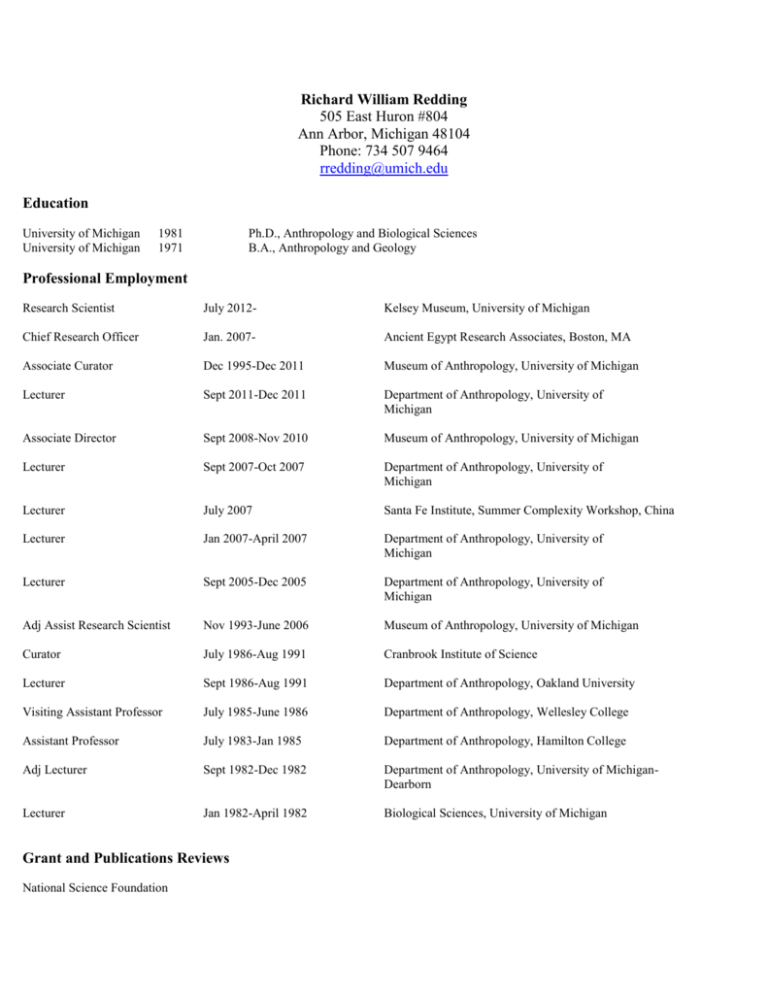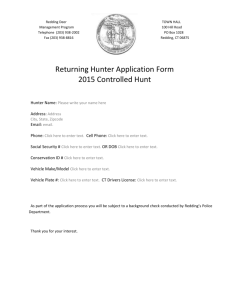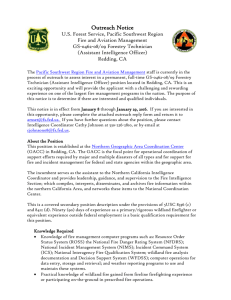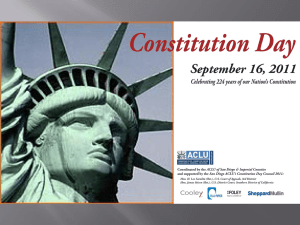View Curriculum Vitae - College of Literature, Science, and the Arts
advertisement

Richard William Redding 505 East Huron #804 Ann Arbor, Michigan 48104 Phone: 734 507 9464 rredding@umich.edu Education University of Michigan University of Michigan 1981 1971 Ph.D., Anthropology and Biological Sciences B.A., Anthropology and Geology Professional Employment Research Scientist July 2012- Kelsey Museum, University of Michigan Chief Research Officer Jan. 2007- Ancient Egypt Research Associates, Boston, MA Associate Curator Dec 1995-Dec 2011 Museum of Anthropology, University of Michigan Lecturer Sept 2011-Dec 2011 Department of Anthropology, University of Michigan Associate Director Sept 2008-Nov 2010 Museum of Anthropology, University of Michigan Lecturer Sept 2007-Oct 2007 Department of Anthropology, University of Michigan Lecturer July 2007 Santa Fe Institute, Summer Complexity Workshop, China Lecturer Jan 2007-April 2007 Department of Anthropology, University of Michigan Lecturer Sept 2005-Dec 2005 Department of Anthropology, University of Michigan Adj Assist Research Scientist Nov 1993-June 2006 Museum of Anthropology, University of Michigan Curator July 1986-Aug 1991 Cranbrook Institute of Science Lecturer Sept 1986-Aug 1991 Department of Anthropology, Oakland University Visiting Assistant Professor July 1985-June 1986 Department of Anthropology, Wellesley College Assistant Professor July 1983-Jan 1985 Department of Anthropology, Hamilton College Adj Lecturer Sept 1982-Dec 1982 Department of Anthropology, University of MichiganDearborn Lecturer Jan 1982-April 1982 Biological Sciences, University of Michigan Grant and Publications Reviews National Science Foundation National Geographic Journal of Anthropological Archaeology Journal of Archaeological Science Paleorient Current Anthropology Weiner Laboratory, American School Classical Studies, Athens Grants See Research Statement for funds raised as a member of AERA 2004-2012 National Science Foundation Collection Improvement Grant, US$24,147, NSF9601062 Co-PI for “Upgrade of the Facilities in the Archaeozoology Laboratory at the University of Michigan” 1996 National Science Foundation Research Grant, US$ 88,423, NSF8718787 Co-PI for “ Prehistoric Egyptian Socioeconomic Structure” 1988 National Science Foundation Research Grant, US$24,347, NSF8407006 Co-PI for “Old Kingdom Economy and Society in the Egyptian Delta” 1984 Fellowships American Research Center in Egypt, Fellow 1983 Service (Last 5 years) Board Member, Ancient Egypt Research Associates Jan 2005-Present Board Member, Wiener Laboratory, American School of Classical Studies in Athens, Greece Jan 2009-Present Member of the International Committee, International Council for Archaeozoology Aug 2004-Aug 2008 Books R.J Wenke, R.W. Redding and P. Buck. Ready for submission. An Old Kingdom Village in The Nile Delta: Excavations at Kom elHisn 1984-1988, Book length monograph. Peer-Reviewed Articles and Book Chapters Redding, R.W. 2010. Status and diet at the Workers’ Town, Giza, Egypt. In Cambr, edited by D. Campana, P. Crabtree, S. D. deFrance, J Lev-Tov and A. Choyke, pp. 65-75, Cambridge, England. Redding, R.W. 2005. Breaking the mold: A consideration of variation in the evolution of animal domestication. In First Steps Towards Animal Domestication, edited by J.D. Vigne, J. Peters, and D. Helmer. Oxbow Press, London. Redding, R.W. 2003. The faunal remains from Chogha Bonut. In Excavations at the Prehistoric Mound of Chogha Bonut, Khuzestan, Iran: seasons 1976/77, 1977/78 and 1996, edited by A. Alizadeh. University of Chicago, Oriental Institute, Publication 120. Redding R.W. 2003. Vertebrate Fauna from the Hellenistic and Roman Layers. In Excavations at Coptos (Qift) in Upper Egypt, 1987-1992, S.C. Herbert and A. Berlin. Journal of Roman Archaeology, Supplementary Series, 53:205-220 Redding, R. W. 2002. The study of human subsistence behavior using faunal evidence from archaeological sites. In Archaeology: Original readings in method and practice, edited by Peter. N. Peregrine, Carol R. Ember and Melvin R. Ember, pp92-110. Prentice Hall, N.Y. Rosenberg, M., and RW. Redding. 1998. Early pig husbandry in southwestern Asia and its implications for the modeling the origins of food production. In Ancestors for the Pigs, edited by S. Nelson. University of Pennsylvania Museum of Archaeology and Anthropology, MASCA Research Papers in Science and Archaeology, 15. 1998 Redding, RW and M. Rosenberg. 1998. Ancestral Pigs: A New (Guinea) model for pig domestication in the Middle East. In Ancestors for the Pigs, edited by S. Nelson. University of Pennsylvania Museum of Archaeology and Anthropology, MASCA Research Papers in Science and Archaeology,15. Rosenberg, M., Nesbitt, R. M., Redding, R. W., & Peasnall, B. L. 1995. Hallan Çemi, pig husbandry, and post-Pleistocene adaptations along the Taurus-Zagros arc (Turkey). Paléorient, 24, 25-41. Redding, R.W. 1993. Subsistence security as a selective pressure favoring increasing cultural complexity. Bulletin of Sumerian Agriculture, 7:77-98. Redding. R.W. 1992. Old Kingdom patterns of animal use and the value of faunal data in modeling socioeconomic systems. Paleorient 18(2). Redding, R.W. 1992. The vertebrate remains. Azania 27:113-117. Redding, R.W. 1991. The role of the pig in the subsistence system of Ancient Egypt: A parable on the potential of faunal data. In, Animal Use and Culture Change, edited by P.J. Crabtree and K. Ryan, pp 20-30. MASCA Research Papers in Science and Archaeology, Supplement to Volume 8 Redding, R.W. 1988. A general model of subsistence change: from hunting and gathering to food production. Journal of Anthropological Archaeology, 7:56-97. Wenke, R.W., et al. 1988. Kom el-Hisn: excavation of an Old Kingdom settlement in the Egyptian Delta. Journal of the American Research Center in Egypt, 25:5-34. Wright, H.T., R.W. Redding and S. Pollack. 1988. Monitoring interannual variability: an example from the period of early state development in southwestern Iran. In, Bad time economics, edited by P. Halstead and J. O'Shea, pp106-113. British Archaeological Reports, International Series. Redding, R.W. 1985. The role of faunal remains in the explanation of the development of complex societies in south-west Iran: potential, problems and the future. Paleorient, 11/2:121-124. Redding, R.W. 1984. Theoretical determinants of a herder's decisions: modeling variation in the sheep/goat ratio. In, Animals and archaeology: 3. Early herders and their flocks, edited by J. Clutton-Brock and C. Grigson, pp223-241. British Archaeological Reports, International Series 202. Redding. R.W. 1984. IV The Faunal Remains. In Archaeological Investigations at El-Hibeh 1980: Preliminary Report, R.J. Wenke. American Research Center in Egypt, Reports 9:39-49 Redding, R.W. 1981. The faunal remains from Tappeh Farukhabad. In, An early town on the Deh Luran Plain: Excavations at Tappeh Farukhabad, edited by H.T. Wright, pp233-261 and 391-426. University of Michigan, Museum of Anthropology. Memoir 13. Redding, R.W. 1981. The bone tools. In, An early town on the Deh Luran Plain: excavations at Tappeh Farukhabad, edited by H.T. Wright, pp49-50. University of Michigan, Museum of Anthropology. Memoir 13. Wright, H.T., N. Miller and R.W. Redding. 1980. Time and process in an Uruk rural center. In, L'archaeologie de L'Iraq perspectives et limites de L'interpretation anthropologique des documents, edited by C.N.R.S., pp263-280. C.N.R.S. Colloques Internationaux 580. Redding, R.W., M.A. Zeder and J. McArdle. 1978. Bonesort II: A system for computer processing of identifiable faunal material. In Approaches to faunal analysis in the Middle East, edited by R.H. Meadow and M.A. Zeder, pp135-147. Peabody Museum Bulletin 2. Redding, R.W. 1978. Rodents and the archaeological paleoenvironment: considerations, problems and the future. In, Approaches to faunal analysis in the Middle East, edited by R.H. Meadow and M.A. Zeder, pp63-68. Peabody Museum Bulletin 2. Redding, R.W., and D.M. Lay. 1978. Description of a new species of shrew of the genus Crocidura (Mammalia:Insectivora:Soricidae) from southwestern Iran. Zeitschrift fur Saugtierkunde 43:306-310. Redding, R.W., J. Wheeler Pires-Ferreira and M.A. Zeder. 1977. A proposed system for computer analysis of identifiable faunal material from archaeological sites. Paleorient 3:191-205. Other Contributions and Reviews Redding, R.W. 2011. Why we excavate where we do. In Giza Plateau Mapping Project Season 2009 Preliminary Report, Giza Occasional Papers 5, edited by M. Lehner, pp. -105-109, Boston Redding, R.W. 2011. The OK Corral: Standing Wall Island Mystery Solved. Aeragram, Vol 12(1); 2-5. Redding, RW. 2007. The faunal remains from the excavations of Main Street. In Giza Reports: The Giza Plateau Mapping Project, Vol. 1: Project History and Survey, Main Street, Gallery III.4, and Ceramics edited by M. Lehner Redding, RW. 2007. The faunal remains from Gallery III.4 In Giza Reports: The Giza Plateau Mapping Project, Vol. 1: Project History and Survey, Main Street, Gallery III.4, and Ceramics, edited by M. Lehner. Redding, RW. 2006. Pyramids and Protein: Of cattle, sheep, goats and pigs. http://www.aeraweb.org/spec_zoo.asp Redding, R.W. 2004. A review of The Mammals of Ancient Egypt, by D.J. Osborn and J. Osbornova. Journal of Ethnobiology, 22(2). Redding, R.W. 2003. The faunal remains from Chogha Bonut. In Excavations at the Prehistoric Mound of Chogha Bonut, Khuzestan, Iran: seasons 1976/77, 1977/78 and 1996, edited by A. Alizadeh. University of Chicago, Oriental Institute, Publication 120. Redding, R.W. 2003. A review of Archaeozoology of the Near East : Proceedings of the Fourth International Symposium on the Archaeology of Southwest Asia and Adjacent Areas. Paleorient. Redding, R.W. 2003. The faunal remains from Chogha Bonut. In Excavations at the Prehistoric Mound of Chogha Bonut, Khuzestan, Iran: seasons 1976/77, 1977/78 and 1996, edited by A. Alizadeh. University of Chicago, Oriental Institute, Publication 120. Wright, HT., N. Miller, RW. Redding and J.A. Neely. 2000. A Late Susiana society in Southwestern Iran. In The Iranian World: Essays on Iranian Art and Archaeology, edited by A. Alizadeh, Y. Majidzadeh, and S.A. Shahmirzadi: 64-79 Redding, R.W. 1998 The faunal remains from Fatmali Kalecik. In Karatepe’deki Isik: Studies Presented to Halet Chambel, edited by g. Arsebuk, M.J. Millink, and W. Schirmer. Ege Yayinlar, Istanbul. Redding, R.W. 1995. The study of human subsistence behavior using faunal evidence from archaeological sites. Research Frontiers in Anthropology. Prentice-Hall, New Jersey. Redding, R.W. 1994. Chapter 7: The vertebrate fauna. In, Tel Anafa, edited by S. Herbert, pp277-322. University of Michigan, Kelsey Museum, Papers in Roman Archaeology. Wenke, R.J., and R.W. Redding. 1987. Excavations at Kom el-Hisn: 1986. Newsletter of the American Research Center in Egypt, 132: 8-18. Wenke, R.J., and R.W. Redding. 1985. Excavations at Kom el-Hisn: 1984. Newsletter of the American Research Center in Egypt, 129:1-11. Redding, R.W. 1984. The faunal materials. In, Archaeological investigations at el-Hibeh 1980: preliminary report, edited by R.J. Wenke, pp39-49. American Research Center in Egypt, Reports 9. Redding, R.W. 1984. Dembeni phase reptile, bird and mammal remains. Azania XIX: 51-54. Redding, R.W., and H.T. Wright. 1979. The paleolithic periods on the Izeh Plain. In, Investigations in northeastern Xuzistan, edited by H.T. Wright, pp33-42. University of Michigan, Museum of Anthropology, Technical Report 10. Redding, R.W. 1979. The faunal remains from Tappeh Zabrajad. In, Investigations in northeastern Xuzistan, edited by H.T. Wright, pp90-92. University of Michigan, Museum of Anthropology, Technical Report 10. Farrand, W.R., R.W. Redding, M. Wolpoff and H.T. Wright. 1976. An archaeological investigation on the Loboi Plain, Baringo District, Kenya. University of Michigan, Museum of Anthropology, Technical Report 4. Manuscripts in Preparation or Under Review Redding R.W. and N. el-Hadidi. 2012. The 2011 Excavations at Standing Wall Island: An Old Kingdom Animal Processing Complex? In Giza Occasional Papers 6, edited by M. Lehner, Boston Redding, R W. The faunal remains from Kom el-Hisn. In An Old Kingdom Village in The Nile Delta: Excavations at Kom el-Hisn 1984-1988 Redding, R.W. The Pig and the Chicken: the Introduction of the Chicken into the Middle East and it relation to the evolution of the human prohibition on pig consumption. 35 mss Redding, R.W. A Tale of Two Sites: Old Kingdom Subsistence Economy and The Infrastructure of Pyramid Construction. 42 mss Conference Presentations and Invited Papers (Last 5 years) Redding R.W. Nov. 2011. Intergration of Data at the Workers’ Town, Giza, Egypt. Paper presented at the American Schools of Oriental Research Annual Meeting, San Francisco Redding, R.W. Oct 2011. Re-constructing Old Kingdom Economy and Social Structure. Invited Paper at the Mit Rahina Field Program, Saqqara, Egypt Redding, R.W. Jun 2011. Giza and Kom el-Hisn. Paper presented at the Archaeozoology of Southwest Asia; Working Group of International Council of Archaeozoology, Brussels, Belgium Redding, R.W. Jan 2011. The AERA Field School Program in Egypt. Paper presented at the American Institute of Archaeology Annual Meeting, San Antonio, Texas Redding, R.W. Dec 2010. A Tale of Two Sites: Old Kingdom Subsistence Economy and the Infrastructure of Pyramid Construction. Invited lecture at the Coetsen Institute, UCLA, California Redding R.W. Nov 2008. The Workers’ Town at Giza, Egypt. Invited paper at Clinton Valley Chapter of the Michigan Archaeological Society, Ann Arbor Redding R.W. Sept. 2008. Excavations in the Barracks at the Workers’ Town, Giza, Egypt. Paper presented at the International Council of Archaeozoology, International Council Meeting, Budapest, Hungary. Redding. R.W. June 2004. Complexity and the origins of domestication. Invited lectures at the Santa Fe Institute summer complexity symposium, Chaingtao, China. Media Riddle of the Sphinx. 2010 Documentary shown on PBS. Science, 1994, Vol 264. “Bringing home the bacon”, by C. Holen. Covers my research New York Times, May 31, 1994. “First settlers domesticated pigs before crops”’ by John Noble Wilford. Covers my research Science, 1998, Vol 282. “Reading the Signs of Ancient Animal Domestication”, by H. Pringle. Quoted extensively Field Work (Last 20 years) Chief Research Officer. Giza Excavations, Egypt: 2007, 2008, 2009, 2010, 2011 Director of Archaeological Sciences. Giza Excavations, Egypt: 2006 Participant. Giza Excavations, Egypt: 1991, 1995, 1996, 1998, 2000, 2001, 2002, 2003, 2004, 2005 Faculty Supervisor. Faunal analysis of Shang Dynasty materials from Qingjao, China, 2004 Particpant. Analysis of the Franchthi Cave material, Greece, 1999, 2000, 2002, 2003 Partcipant. Excavations at Kadesh, Israel: 1999, 2000, 2004, 2007 Participant. Excavations at Xen Ren Dong and Wong Dong, China. 1994, 1995 Participant. Abydos Settlement Site excavations, Egypt: May 1993. Participant. Excavation at Halan Chemi, Turkey: July 1992, 1994, 1996 Participant. Wellesley College excavations and survey in Georgia and Armenia: July-August 1991 and August 1992 Participant. Giza Plateau survey and excavation, Egypt: May-June 1991 Participant. University of Michigan excavation and survey around ancient Coptos, Egypt: December- January 1991, May-June, 1992 and December, 1993. Co-Investigator. Excavation of an Old Kingdom village site in the Nile Delta, Egypt: June-August 1988. Co-Investigator. Excavation of an Old Kingdom village site in the Nile Delta, Egypt: June-August 1986. Co-Investigator. Excavation of an Old Kingdom village site in the Nile Delta, Egypt: June-August 1984 Co-Investigator. Survey and Excavations in the Western Fayyum, Egypt: 1981 Courses Taught Introduction to Faunal Identification and Analysis (2011, 2007, 2005, 2003, 2001, 1999, 1996) Origin and Evolution of Pastoralism (2007) Introduction to Archaeology (1991, 1990, 1989, 1988, 1987, 1986, 1985, 1983, 1984, 1982) Egyptian Archaeology (1991, 1990, 1988, 1987, 1986, 1984, 1983) God(s), Aliens and Myths (1983, 1984) Evolutionary Biology and Anthropology (1984) Human Evolution (1983, 1984) Since 2004 I have worked with 21 undergraduates in the Archaeozoology Laboratory. Two of these went onto graduate work in Archaeology at Chicago and UNLV. I have supervised four honor’s theses. Since 2004 I have worked with 5 graduate students in the Archaeozoology Laboratory. Two of the five, Li Min and Stephen Dueppen have completed dissertations that had an archaeozoology focus. Two of the five, Amy Nicodemis and Matt Kroot, are completing dissertations that have an archaeozoological focus. The fifth, Emily Holt, is working on a dissertation with an archaeozoological focus. Dissertation Committees (Last 5 years) Outside Committee Member, Lauren Bigelow, Northwestern University, 2010 External Reviewer, Louise Bertini, Durham University, UK, 2011





